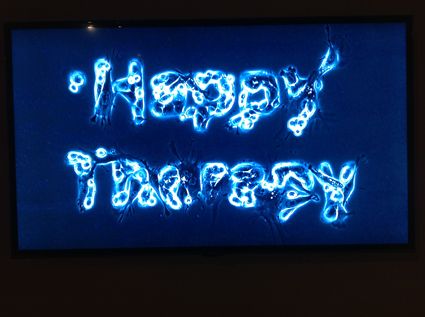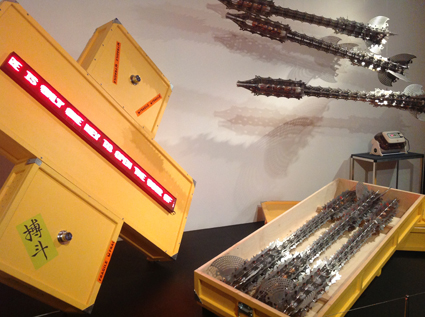July 24 2013
Past-present tensions
Keith Gallasch, Naala-Ba (Look Future), Carriageworks and ISEA2013
July 3 2013
Data noise & the limits of dance
Keith Gallasch, Myriam Gourfink & Kaspar Toeplitz, Breathing Monster
June 26 2013
Nailing the virtual
Virginia Baxter, Keith Gallasch, The Portals
Night work
Keith Gallasch, Embodied Media, Night Rage
Palpable virtualities
Keith Gallasch, Paula Dawson, Holoshop: Drawing and Perceiving in Depth
The big connect
Somaya Langley, The Portals
Transformational walking
Anne Phillips, Long Time, No See?
June 18 2013
Musical multiverses
Gail Priest, Polysonics
Rainbow over ISEA
Keith Gallasch, Electric Nights
realtime tv @ ISEA2013: Zydnei, Troy Innocent
June 17 2013
If a system fails in a forest, is anybody listening?
Urszula Dawkins, If a system fails in a forest…, 107 Projects
June 16 2013
In the digital age, love your stationery obsession
Urszula Dawkins, Durational Book
Painting by algorithms
Keith Gallasch, Ernest Edmonds: Light Logic
June 15 2013
Home, sweet home
Urszula Dawkins, disSentience, Sleeth, SelgasCano, Tin Sheds
Pop up pleasure zones
Gail Priest, Electronic Art Pop-Ups, The Rocks
June 14 2013
Aural ecologies, mechanical and musical
Urszula Dawkins, EchoSonics, UTS Gallery
June 14 2013
Heck, baby, I shoulda seen it comin…
Urszula Dawkins, The Very Near Future, Alex Davies
More than meets the eye
Virginia Baxter, Keith Gallasch, Point of View
New tools and old skool grammars
Gail Priest, Macrophonics II
realtime tv @ ISEA2013: The very near future, Alex Davies
Start by leaping off a small stool
Urszula Dawkins, ISEA Closing Keynote Address: Julian Assange
June 13 2013
A curative dose of spontaneity
Lauren Carroll Harris, pvi collective, Deviator
M e d i a a r t t h e n a n d n o w
Darren Tofts, Catching Light, Campbelltown Arts Centre
Olfaction, decay & speculation
Gail Priest, Raewyn Turner & Brian Harris, Ian Haig, Nandita Kumar, Verge Gallery
ART, WELLNESS & DEATH
Riding the theta waves
Urszula Dawkins, Theta Lab, George Poonkhin Khut and James Brown
Run for your lives [2]
Keith Gallasch, Running the City, COFA, UNSW
To re-map and reclaim
Lisa Gye, Mapping Culture [panel]
Turning the media back on itself
Lisa Gye, Mark Hosler, Adventures in Illegal Art
June 12 2013
Outside the labyrinth…looking in at someone waving
Urszula Dawkins, SoundLabyrinth, Mark Pedersen and Roger Alsop
realtime tv @ ISEA2013: semipermeable (+), SymbioticA
Run for your lives [1]
Keith Gallasch, Marnix de Nijs, Run Motherfucker Run
June 12 2013
The uncanny in the gallery
Keith Gallasch, Mari Velonaki, Simon Ingram, Petra Gemeinboeck & Rob Saunders, Artspace
June 11 2013
realtime tv @ ISEA2013: EchoSonics, UTS Gallery
The science and art of tangible things
Urszula Dawkins, Synapse: A Selection, Powerhouse
Touch me there
Gail Priest, ISEA Artist talks: Siu, Baumann, Velonaki
June 10 2013
Being Stelarc
Gail Priest, Stelarc: Meat, Metal, Code: Engineering affect and aliveness
Life and death, and the membranes inbetween
Urszula Dawkins, semipermeable (+), SymbioticA
realtime tv @ ISEA2013: Catching Light, Campbelltown Arts Centre
June 9 2013
'Pure' experience, in the round
Urszula Dawkins, Pure Land, iCinema
Data lives
Gail Priest, Genevieve Bell, Mark Hosler, Paolo Cirio & Alessandro Ludovico
realtime tv @ ISEA2013: Velonaki, Ingram, Gemeinboeck & Saunders, Artspace
June 8 2013
Knowing your place in Cartesian space
Gail Priest, Ryoji Ikeda, datamatics [ver 2.0]
Stars and starlings, pixels and picknickers
Urszula Dawkins, Ryoji Ikeda, datamatics [ver 2.0] & test pattern
 |
Verena Friedrich, Cellular Performance, 2011-12, still
|
From the recognisably organic form of a lab-grown tree-fungus dress to slick, cold-steel missiles like infiltrating spores, the works in SymbioticA’s semipermeable (+) elicit both pleasure and discomfort as they push science, and ‘wet biology practices’ in particular, towards and through a range of conceptual limits. I reached semipermeable (+) after a stroll through Experimenta’s Speak to Me, sharing the Level 4 Powerhouse space. Stepping from the family-filled, playful halls of twittering mechanical peacocks and kaleidoscopic turntables into a room full of cool glass, metal clamps and tubing was indeed like slipping through a membrane.
WA’s SymbioticA is world-renowned for its emphasis on hands-on collaborations between artists and scientists; for pushing the bounds of biotechnology and prodding with equal vigour at its ethical limits. While a few works in semipermeable (+) eschew the lab-ware in favour of traditional installation, the overall aesthetic is strongly grounded in the microscopic, the genetic, and forms of living (or dead) containment.
A hallmark of SymbioticA is the work of founder Oron Catts with Ionat Zurr, and it’s great to see their now-iconic Victimless Leather (2004) here – a living, miniature coat grown from continuously dividing human and mouse cell lines, and ‘fed’ by an automated nutrient drip. Alongside it is a new work by Catts, Zurr and Corrie van Sice, The Mechanism of Life – After Stephane Leduc (2013). Pointing to Leduc’s 1911 theory that life is merely a chemical process, a custom-built apparatus ‘prints’ blobs of ‘protocells’ into a petri dish, the inks and dyes spreading to form hexagonal arrays that miraculously ‘grow’ before your eyes.
From life, to un-life: a dead cane toad makes music – albeit very, very quietly. It’s a sort of fuzzy, low, soft sound, usually inaudible, but processed for the human ear in Cat Hope’s Sound of Decay (2013). The corpse itself is a vaguely disturbing form almost obscured by the condensation that lines the walls of its sealed glass container, and as such evokes death and a kind of elongated time-scale more surely, perhaps, than a clear view.
German artist Verena Friedrich takes the endless promises of the cosmetic industry and manipulates skin cells to tout the benefits of ‘cosmeceuticals’, displaying the results in a video installation titled Cellular Performance (2011–12). Rendered in electric blues, stark whites and rich blacks, the cells with their tree-like appendages and neon brightness form words: natural living things infused with a decidedly ambiguous dose of consumer culture.
 |
Nigel Helyer, Supereste ut Pugnatis (Pugnatis) ut Supereste (SPPS), 2013 (installation, detail)
|
Almost opposite Friedrich’s micro-billboards, Nigel Helyer’s slick, steel, contaminant-bearing missiles evoke both fertilisation and all-out biological warfare at macro scale. Intricately detailed, their crafting is both sci-fi and organic, reminiscent of Maria Fernanda Cardoso’s Museum of Copulatory Organs (Sydney Biennale, 2012). Carrying SPPS – “an omnisexual bacterium, ingesting histories and narratives that connect through powerful metaphorical bonds” – Helyer’s missiles have a disturbing ‘biological’ appearance, less like bombs than seed carriers shot across borders with the aim of catching their sharp fins on unsuspecting hosts.
Several further works in semipermeable (+) employ the use of cultures and cell lines: foreskin cells reverse engineered to create a functioning neural network (Guy Ben-Ary and Kirsten Hudson); a human/canine hybridoma (Benjamin Forster); fluorescently transformed embryonic kidney cells; virally ‘tattooed’ skin cells (Tagny Duff). These explorations of ‘what we can do’ with biological matter feed an artistic space that holds many conflicts – and there’s a strong sense of the (desirable or undesirable?) ‘semipermeability’ of a natural domain whose borders were once considered impenetrable.
The ubiquity of sealed glass cases, plugged flasks and contained fluids – all necessary for containing the biohazards or fragile life-forms within – has a certain irony, given the theme of the membrane and its qualities of porosity, transfer and exchange. In semipermeable (+), we are locked out of life’s processes, except when they are simulated. And this, in a sense, is telling: the rigidity of our control over nature demands that we’re protected from the renegade species, from the contaminant, from the challenge to our integrity – whether it’s from biohazard or infiltrating thought. The mix of sterile glass and proliferating life (or death) within is potent; because ultimately the ideas that emerge around this work are what slip across our perceptive borders, infecting us whether we touch, breathe, brush up close, or not.
semipermeable (+), SymbioticA, Powerhouse, 8 June – 21 August; http://www.isea2013.org/
This article first appeared on RT's ISEA2013-in RealTime blog
© Urszula Dawkins; for permission to reproduce apply to [email protected]
Back to top










 back
back